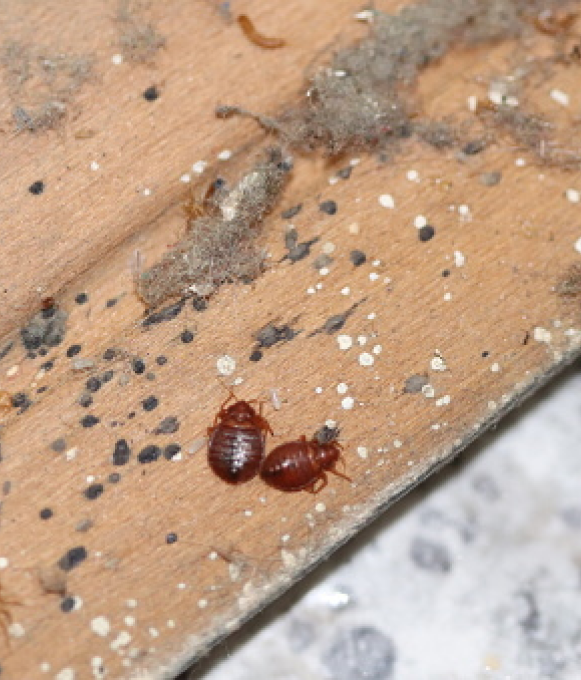Bed Bugs
It is annoying to wake up on a luxurious hotel, expecting to relax and have a great time, only to find out that bed bugs feasted on you when you were sleeping! Instead of wearing that new swimsuit or trunks that you just bought, you feel insecure about the bumps that surround your skin. Now, your vacation is ruined!
It is annoying to wake up on a luxurious hotel, expecting to relax and have a great time, only to find out that bed bugs feasted on you when you were sleeping! Instead of wearing that new swimsuit or trunks that you just bought, you feel insecure about the bumps that surround your skin. Now, your vacation is ruined!
What is a Bed Bug?
Bed bugs are small, reddish-brown parasitic insects that unsuspectingly bite you when you are asleep. In the ecosystem, they serve a purpose by being a food source for spiders. Bed bugs don’t prey on other insects for food supply but instead, feed on animal blood.
Bed bugs don’t fly, but they can surely crawl rapidly. In their mature age, bed bugs can grow about 3/16 inches long, and they are usually mistaken as ticks, cockroaches, or other household insects. Bed bugs have an exoskeleton that molts 5 times in order for them to grow larger as an adult.

Feeding Behavior
Bed bugs can hide in cracks and crevices of beds, bed frames, headboards, or any other areas where they will not be disturbed. Places with a high turnover of nighttime guests such as hotels or hospitals might be one of the riskiest places in encountering bed bugs. They become active at night when the human hosts are typically in their deepest sleep.
Bed bugs are attracted to body heat, as well as carbon dioxide from human exhalations. Once the bed bugs reach the human hosts, their mouthparts would search for capillaries under the skin to suck blood into their bodies for 5-10 minutes. They usually feed every 3-7 days.
Mating Behavior
Bed bugs, especially the males, are interested in mating after feeding. They have a unique method of mating called traumatic insemination where the male bed bug tackles the female bed bug and stabs his genitalia on her right side, called the Organ of Berlese. The male bug’s sperm is released into the female body’s cavity which will travel to her ovaries after a few hours.
The females’ process of healing plays an important role in bed bug reproduction. Females leave their groups after insemination to avoid any further abuse from other males, which also gives her time to heal from the scars. It is shown that single-mated females produce 25% more eggs than those who are mated repeatedly.
Signs of Bed Bug Infestation
- Musty Odor - Bed bugs emit a pheromone that alarms other bed bugs of danger. Normally, a single bed bug only produces a faint scent. But if you are already having an infestation, these collective scents grow stronger, along with the smell of dead bed bugs, excrement, and sheddings.
- Bloodstains - If you move a lot when you sleep, chances are, you might have probably rolled on and crushed an unlucky, bloated bed bug full of your blood in their stomach. This would cause the blood to leak out and stain your sheets. It might also be from the bitten areas that have not stopped bleeding for a short while.
- Fecal Stains - Just like any other insects, bed bugs also produce wastes that consist of digested human blood. It may resemble an ink dot from a pen or a marker, and is usually seen grouped together with other fecal stains. If you ever see this on fabric, note that it can be difficult to wash off as it smears when you rub it.
- Eggs - It is normal for insects to lay eggs frequently to prolong their genes. Be sure to look out for bed bug eggs since they usually lay 1-7 eggs per day. The eggs look like 1mm long, oval, pearly-white granules that look like rice.
- Sheddings - To be able to grow into mature adults, bed bugs, have to molt from their exoskeleton 5 times in their lifetime. Their shell casings are pale yellow, translucent, and hollow outlines of their body shapes.
- Actual Bed Bugs - The most obvious sign is when you actually spot a bed bug on your premises. However, because they are smaller than apple seeds and like to hide in secluded areas, fecal stains and shell casings are much easier to find. If you finally found a live bug, that is strong evidence of bed bug infestation.
Bed Bug Infestation Prevention tips:
- Free Your Floor From Clutters
Do you leave your clothes on the floor? It’s best to stop that habit to prevent bed bugs from clinging to your favorite jacket and possibly infecting your dresser. - Don’t Store Items Under the Bed
The space under your bed is a good place for bed bugs to hide and take shelter. Keeping things there might not only prevent you from spotting bed bugs, but you might unknowingly infect that area as well. - Use Plastic Containers
Bed bugs don’t like smooth surfaces, so it might be the best storage for your belongings, especially if you go to a place with high people turnover. - Vacuum or Sweep Regularly
Doing this could lessen the chance of an infestation. Just be sure to throw your gathered dirt outside and place it in a secure bin. - Inspect Your Lodging Area
We get that you are on a trip and you just want to get the unpacking stage over with. Checking your area for bed bugs first could go a long way. Bed bugs might hitch a hike on your baggage and infect your home once you get back. - Don’t Settle for ‘Clean’ Clothes
Just because you did not use some of your clothes from a trip does not mean you don’t have to wash them. Bed bugs might hide inside your bags and get cozy on your clean clothes. Make sure you wash them when you get home. - Be Careful with Bargain or Free Furniture
That couch you saw on the flea market might be too tempting to buy, but you don’t know where it came from. You might not see it on your initial inspection, but bed bugs might be hiding in that couch, like the Greeks in the Trojan horse! - Wash Your Sheets Regularly
A clean sheet does not only feel good to lie down on, it can also prevent bed bugs from accumulating in your bed. Wash your sheets once a week and make sure to use hot water to kill any unsuspected bed bugs.
Sources: https://www.healthline.com/health/how-to-prevent-bed-bugs#prevention-tips
https://www.lawnstarter.com/blog/pest-control/ways-to-prevent-bed-bugs/
https://www.webmd.com/skin-problems-and-treatments/guide/bedbugs-infestation
https://entomology.ca.uky.edu/ef636
https://www.webmd.com/skin-problems-and-treatments/guide/bedbugs-infestation

Why is Bed Bug Control Necessary?
Bed bugs are sneaky little creatures that could easily sneak up on you when you least expect it. Unless it bites you and you wake up with itchy bumps on your skin, you wouldn’t know they are around. Bed bug control is better done by professionals since they can give you a peace of mind that no bugs could ever ruin your sleep. They can give you accurate diagnostic on your bed bug situation and use the proper technique to eliminate them.
We, at SureSolutions Inc., only want the best results for you and your properties, and as pest control professionals, we are here to make sure that bed bugs in your property are completely eradicated.










